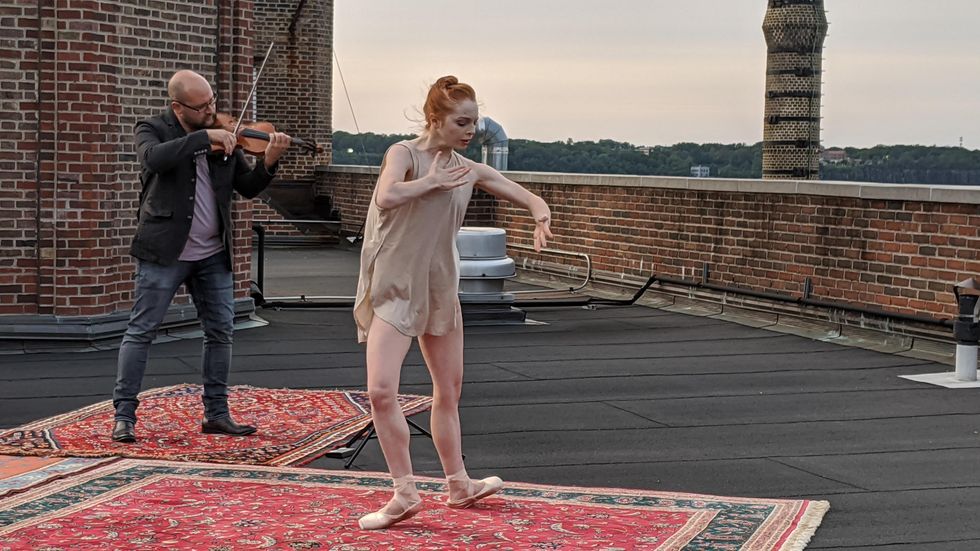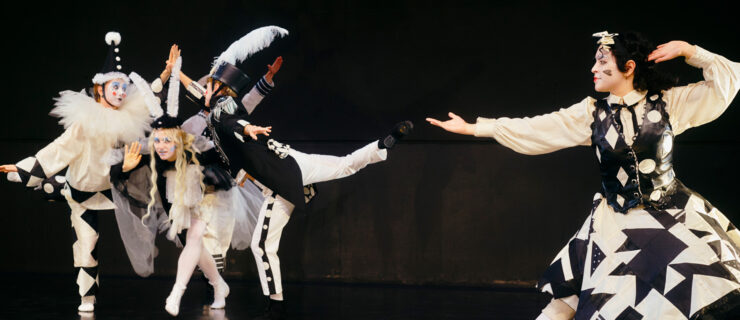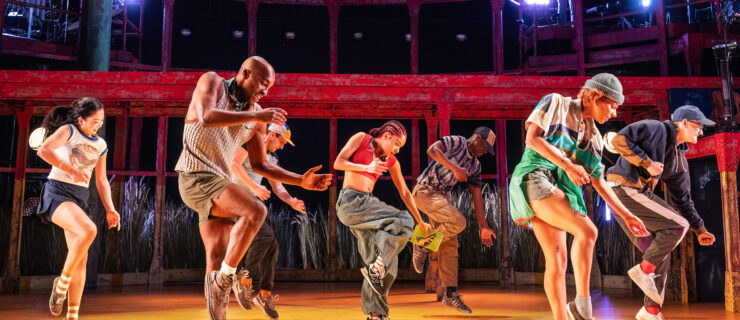No Theater? No problem. Dancers Are Making the World Their Stage
As we continue to redefine what constitutes a stage, many dancers and choreographers have taken to the great outdoors, a safer alternative during the pandemic. From parking garages to lakes and rooftops, outdoor performances can be exhilarating for artists and audiences alike. Vistas that would be impossible to re-create onstage are now more available. Yet, without the highly controlled environment of a theater, we open ourselves to some compromises, mishaps and the great unknown of the weather.
Nature as an Audience
Having worked with choreographer Gabrielle Lamb two years in a row in the ABT Incubator program, American Ballet Theatre corps member Zimmi Coker jumped at the chance to be part of Lamb’s outdoor Carpet Series, in which Lamb presented performances on a Persian rug lugged around New York City. For a film version of the piece, Coker found an uplifting majesty in performing on a rooftop above the Hudson River. “Being alone was definitely mentally hard,” says Coker of performing without a live audience. “But outside, I feel like nature is like an audience. I get so much energy.”
For better maneuvering on the rug, Lamb had a cobbler add an extra layer of moleskin to Coker’s pointe shoes. But the natural elements remained out of their control. During the final take, the gentle breeze morphed into a strong wind that flipped up the rug, attacking the violinist. “We took that as a sign from nature that we were done,” says Coker.
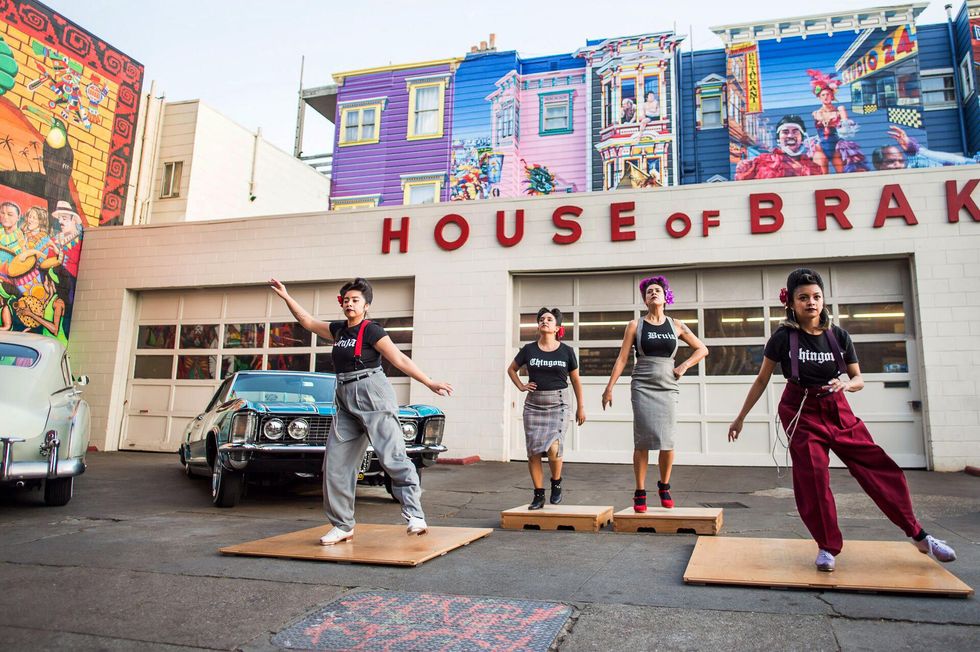
Courtesy KQED Arts
Tapping Through the City
Vanessa Sanchez and her company, La Mezcla, tap through San Francisco’s Latinx-centered Mission District as if they own the place in the KQED film series “If Cities Could Dance.” As they perform, the colorful streets and La Mezcla’s vibrant dancing both come alive.
What viewers don’t notice is all the audio technology the filmmakers and Sanchez had to leverage to make sure every tap could be heard amidst the urban clatter. Nor would most realize that the dancers had sprung wood platforms to keep their bodies safe from injury.
“There isn’t a lot of tap in the Bay Area, so we often have to tell people that, no, we can’t tap on the sidewalk,” Sanchez says.
Based in Chicana, Latinx and Indigenous traditions and social justice, La Mezcla showcases tap dance, Zapateado Jarocho (traditional footwork from Veracruz, Mexico) and Afro-Caribbean rhythms. For the KQED series, Sanchez adapted a section of her Pachuquísmo, which examines the female experiences of the 1940s Zoot Suit Riot era. In the outdoor version, the dancers step out of a 1950 olive green Chevy Fleetline Deluxe in front of The House of Brakes.
“Dancing on the streets alongside neighborhood lowriders and colorful murals of artists and activists that came before us brought a whole new cultural vibrancy and energy to our performance,” Sanchez says.
She is now investing in portable tap floors so her company can continue to perform outdoors. “This is going to go on for a long time,” she says.
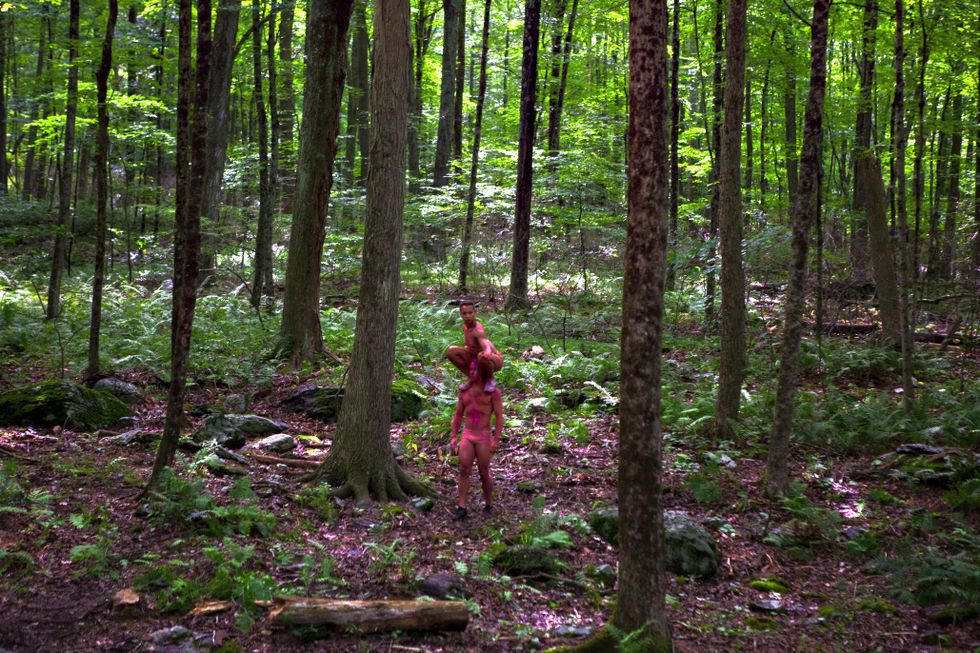
John Kane, Courtesy Pilobolus
Dancing Down a Hill
Trained as an actor, gymnast, figure skater and dancer, there isn’t much Pilobolus’ Quincy Ellis won’t try. Thus far in his performance career, he’s danced in the woods, on concrete, on asphalt, on rooftops and over guardrails, and tumbled on the grass. “Okay, the grass didn’t turn out so well, when I learned the hard way during a performance of Branches that I am allergic to grass,” recalls Ellis.
His most recent challenge occurred during Pilobolus’ Five Senses Festival last summer, which involved traveling downhill in the thick woods with fellow dancer Isabella Diaz on his shoulders. The woods might sound quaint, but as a dancing surface, it’s not a welcoming place. “We are talking uneven terrain, roots, leaves and sticks,” says Ellis. “We definitely needed to make a clearing.”
Pilobolus performed the entire piece 14 times a day over a two-day period. For Ellis, that meant repeating his seven-minute section with just a one- to two-minute break between his performances. “It was like being part of an amusement ride,” he says.
Early on in the rehearsal process the company realized its dancers needed some provisions, like bug spray, water and snacks. “The tick count was very high this year, so we would regularly check each other for ticks,” he says.
That didn’t stop them. “We are a group of daredevils and don’t shy away from wild ideas,” Ellis adds. “If someone thinks it might be cool to jump out of a tree, we rarely say no, but we also want to do it safely.”
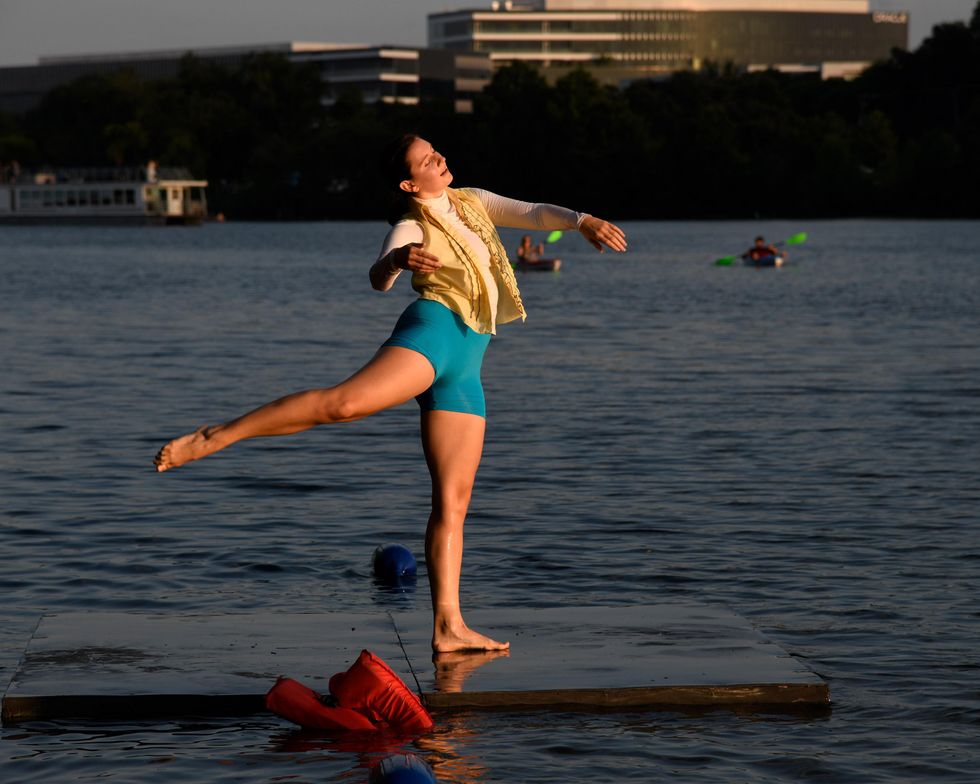
Texas. Fluxion Photography
All the Lake’s a Stage
When executive artistic director Kathy Dunn Hamrick emailed her eponymous company saying she wanted to test the waters for a new idea, dancer Cara Cook wasn’t expecting the dance to be on actual water. But once she realized that At a Distance would take place on specially designed platforms on Austin’s scenic Lady Bird Lake, she was all in. “I loved the idea of performing again, and in an entirely new way,” says Cook. “And, yes, strong swimming skills were a prerequisite.”
Hamrick imagined At a Distance happening multiple times in pop-up shows, with the platforms sometimes anchored near shore, sometimes free-floating and sometimes towed by kayaks or paddle boards so they were traveling down the lake.
Her first time on the floating platform, Cook was nervous. But she got the hang of the process early on and was amazed at how much she could actually do. “Sustained balances were tricky,” she says. “You really needed to be aware of your center. Balance is not the same on water. You have to react very quickly and be present to change.”
To add to the challenge, the platform would sometimes submerge, especially when there was jumping involved. “I would plié and the surface would go beneath the water, but while I was up in the air it would return, so I would land sooner than I expected,” says Cook.
Runners, bikers, walkers and kayakers looked up from their activities to see something amazing. For Cook, it was a performance experience of a lifetime. She says, “To look out and see the water, the sky, the trees. With my view constantly changing, my senses were so heightened.”
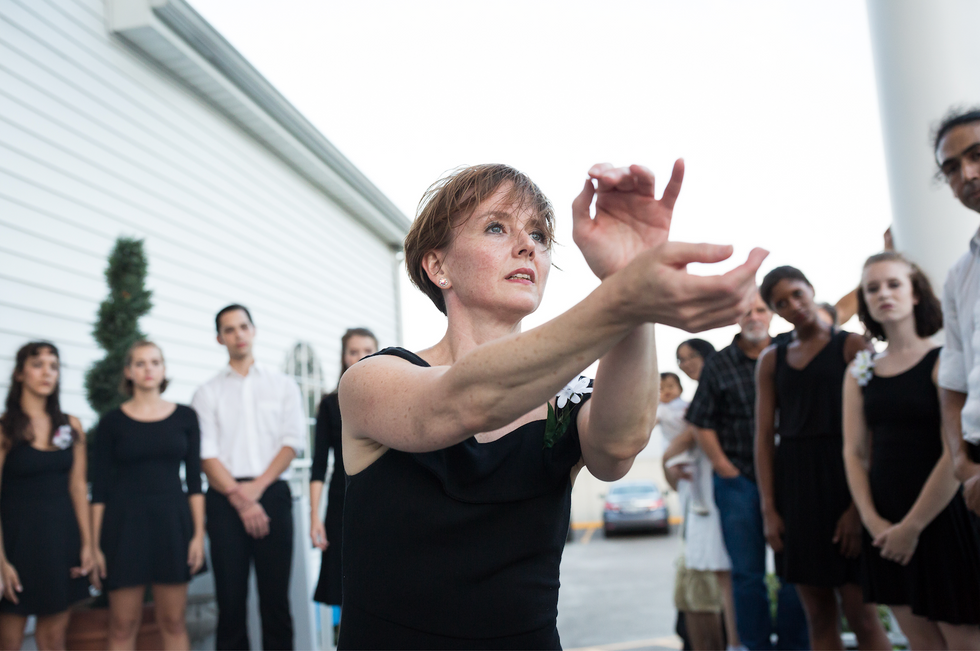
Requiem, outside Houston’s Morales Funeral Home Lynn Lane, Courtesy Mabus
Parking Garage Theater
Jennifer Mabus did her MFA thesis at Sam Houston State University on immersive dance theater, with an emphasis on site-specific work. “The outdoors is unpredictable, and you must be prepared for that,” says Mabus. She laughs when she tells the story about how she found herself quite unprepared when a parade, complete with police sirens, joined her during her thesis performance.
Since then, and especially during the pandemic, she has danced on such surfaces as grass, dirt, concrete, brick and seagrass. “The surface and space impact the choreographic choices that you can make,” she says. “Restrictions can create something new by forcing you to solve problems.”
Now as University of St. Thomas’ dance program director, she is bringing her site-specific smarts to her students, most recently in the fall concert at the university’s rooftop parking garage, where the audience had the option to remain in their cars.
“It’s best to think of the space as another performer, even the audience might be in the performance,” says Mabus. “In outdoor performances, the audience is also more visible to the dancers and each other. I love the interactivity.”
As a director, Mabus wants to keep her dancers warm, safe and dry. As a performer, she’s willing to dance just about anywhere. “We are desperate to be who we are and do what we do,” she says.
She still remembers a surprise during her first performance upon returning to Texas after leaving Robert Battle’s Battleworks Dance Company. “We were dancing on the lawn of this historic home and started to smell something. I looked down and realized I had just rolled in dog poop,” she says, with a laugh. “That was my welcome to Texas.”
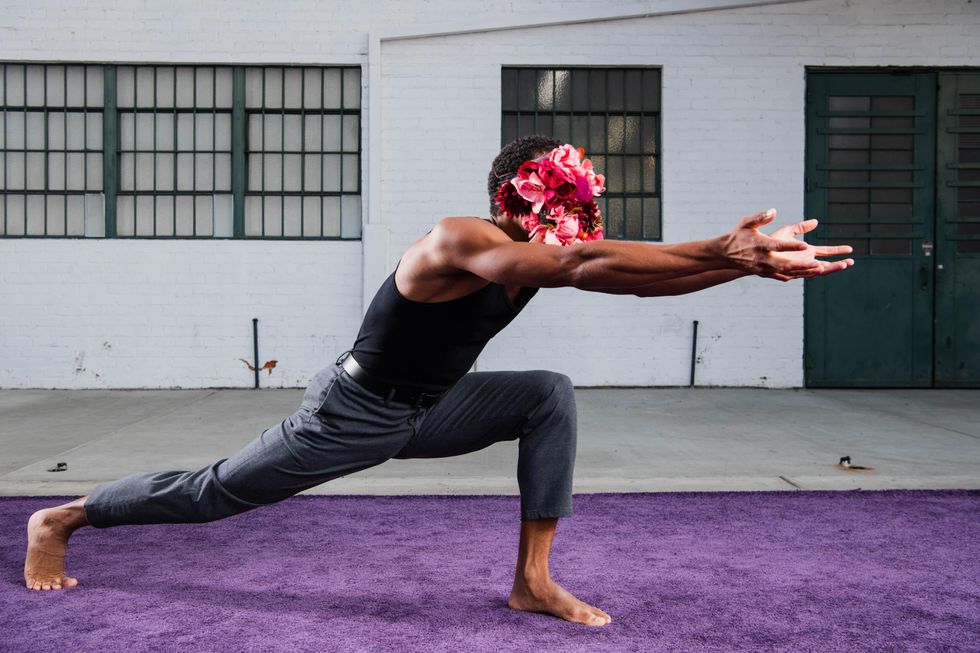
Solo at Dusk Josh S. Rose, Courtesy L.A. Dance Project
Dancing for Cars
Pre-COVID-19, when L.A. Dance Project member Anthony Lee Bryant would be holed up in a studio looking at the sky, he wondered, Why can’t we be outside?
Circumstances have changed. “I am living the dream that I had,” says Bryant. “I love the outdoors, especially when it’s hot.” L.A. Dance Project is known for its site-specific work, and Bryant is mostly all in. However, he admits, “At 33, I’m not a fan of concrete.”
He got the heat, plus the cold and poor air quality from wildfires, while performing Bobbi Jene Smith and Or Schraiber’s Solo at Dusk. Rehearsals began in the summer and performances ran through the fall months of 2020, necessitating a change to warmer costumes for the last few shows. A bright purple rug covered the specially designed foam-topped platforms that made up the stage. “Rug burn was a thing,” he says, “and sometimes it got wet because of condensation, so we covered it with a tarp.”
The audience remained in their cars. “Okay, that is weird—you can’t see the people in their cars,” he says. “And it’s super-strange when they forget to honk or flash their lights at the end. Some people get it. But overall I think the idea of drive-in dance is kinda cool.”
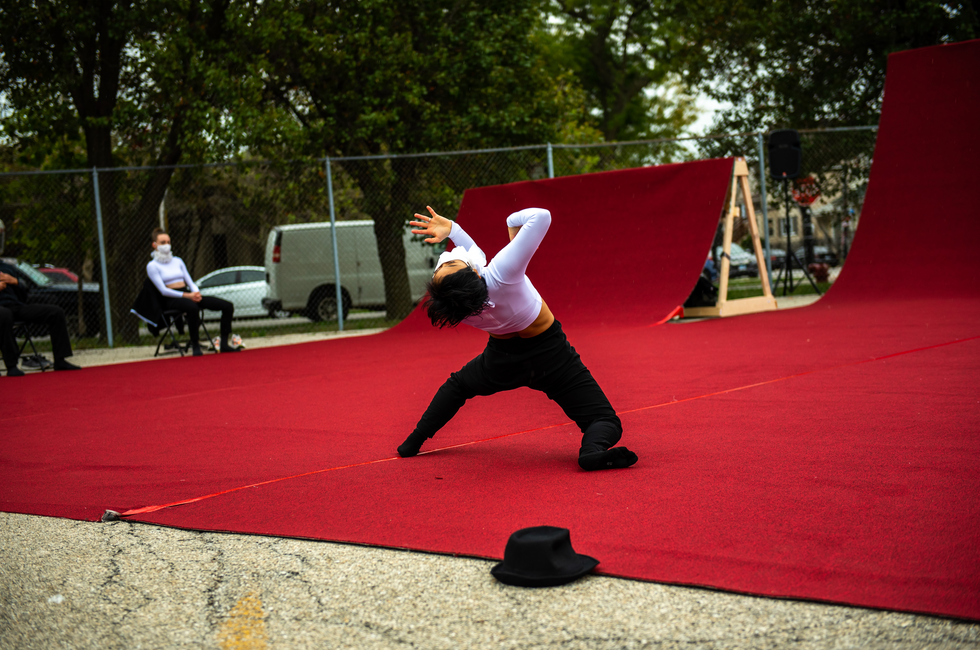
kiss. Michelle Reid, Courtesy PARA.MAR Dance Theatre
The Red Carpet
When Ching Ching Wong took her first steps wearing only socks on the brilliant red carpet that had been laid down in a parking lot for a PARA.MAR Dance Theatre performance of kiss., she could feel bits of gravel beneath it. “It was like mini mountains under my feet,” remembers Wong. Determined to create a danceable surface, artistic director Stephanie Martinez, rehearsal director Noelle Kayser and the whole PARA.MAR team spent hours sweeping the area and filling holes with sand. “The next day for the performance it made such a huge difference,” Wong says.
During her stint at NW Dance Project and other companies, Wong has danced outdoors on all kinds of unforgiving surfaces. She finds she needs to shift her training to prepare for the additional demands on her body, so in addition to Pilates and daily ballet, she also does more strength and cardio workouts, including weights. “It’s good to keep the bones intact.”
It rained during one of the performances of kiss. “Okay, so our socks were wet. But we had nothing to complain about,” Wong insists. “We are dancers, our superpower is adaptability. This is such a gift to be able to dance right now.”
